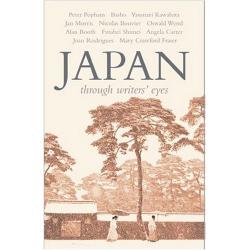Japan Through Writers’ Eyes

Eland Publishing Ltd., 2009, 336 pages, ISBN: 978-190601108-6 (Paperback) £12.99
Review by Susan Meehan
Japan through writers’ eyes is a literary companion or guide to Japan, in which freelance writer and former Japan-resident, Elizabeth Ingrams, includes poetry, fiction and nonfiction excerpts from an impressive breadth of writers such as Matsuo Basho, Jonathan Swift, Rudyard Kipling, Lafcadio Hearn, Yasunari Kawabata, Jan Morris, Alan Booth and Angela Carter. The scope of the book is testament to Ingrams’ enthusiasm. Japan is, according to her, “the best country thus discovered.” The book, a lyrical and informative journey throughout Japan, can be challenging at times – and I was grateful for the reminder of places and protagonists in the tale of the Taira and Genji clans which were thoughtfully included in the introduction to the Hiroshima and Chūgoku section.
Japan through writers’ eyes was launched at Asia House on 19 March 2009 with brief speeches by Elizabeth Ingrams, Timon Screech (Professor of History of Art, School of Oriental and African Studies, University of London), the author Lesley Downer and travel writer Joanna Hunter.
Timon Screech referred to Ingrams’ edited book as “wonderful” thanks to the richness of writers’ responses to Japan. Japan was considered “worthy”of Europe, thus attracting many visitors, remarked Screech, though visitors often found Japan quirky. In Jonathan Swift’s Gulliver’s Travels, for instance, the hero visits a host of imaginary countries and Japan, in a way conveying a sense of its unintelligibility according to Screech.
Ingrams begins her guide with Tokyo, deftly whetting the travellers’ appetite by introducing the reader to the gokaidō, the five major connecting highways which started in Edo (Tokyo) and were built in the Edo period (1603-1867) and by introducing the authors whose extracts have been used.
Tokyo is the most comprehensive section of the book with sub-sections including the Edo (1603-1867), Meiji (1868-1912), Taishō & early Shōwa (1912-1926), and Postwar periods. Ingrams includes excellent, sweeping and well-researched backdrops to each of the Tokyo sub-sections, helping put all the selected pieces in historical and cultural context as well as telling us about each author. The introductions to all the other following chapters and areas of Japan are also hugely helpful.
The book certainly captivates and transports the reader to Japan. I was reminded of Japanese writers I wish to revisit such as Kawabata and Sōseki and prompted to stock up on books not yet read such as Nicolas Bouvier’s Japanese Chronicles, having enjoyed the carefully chosen snippets of the Swiss author’s beautifully written and meditative reflections, a contrast to the Donald Richie excerpt from Tokyo Nights also in the first section which focuses on modern-day Ginza with its Western-style bars and cafes. The different writing styles and perceptions throughout the book complement each other well.
The book presents many gems. In the same way that Lesley Downer admitted to being very much taken with Henry Heuksen, Townshend Harris’s Dutch-speaking interpreter, and Ernest Satow, British diplomat in Japan and scholar, I was taken with the Edmund Blunden and Oswald Wynd excerpts.
At the risk of being fussy, I have to admit being disappointed by the Nara section, which mainly concentrated on Hōryū-ji and focused on poems. Having been founded in 710 and having been the first great Japanese capital, I felt that it deserved more than 7 pages dedicated to it.
I also felt that there was an over-emphasis on Bashō, who seemed to pop up every now and then, though he was a traveller extraordinaire.
I thoroughly enjoyed reading Natsume Sōseki in the Tokyo section, and felt that excerpts from his novel Botchan, set in Matsuyama, could also have been included in the Shikoku section. This exclusion is a shame as Botchan’s visits to the Dōgo onsen and his noodle-eating excursions are flavoursome of the place and one cannot visit Matsuyama without tripping over Botchan dango (three-skewered rice dumplings).
Screech alluded to the absence of Chinese writing on Japan, at the book launch, saying it was very interesting and perhaps bred of Chinese cultural arrogance. There is, however, much Korean writing on Japan, said Screech. Perhaps the next edition of the book could include some tasters from Korean and Korean-Japanese writing.
As Ingrams says, however, the guide does not pretend to be a comprehensive or exhaustive literary anthology: “The aim is to provide some inspiration to explore a country full of treasures, whether literally or through the imagination.”
The book is certainly an inspirational treasure trove.

